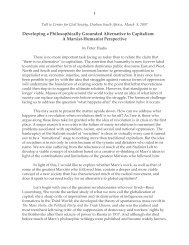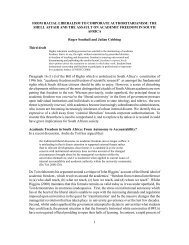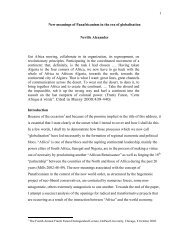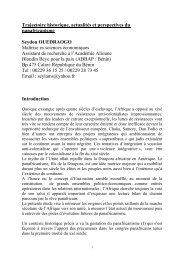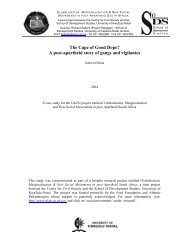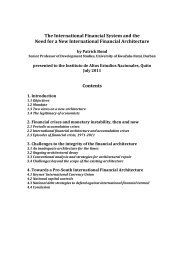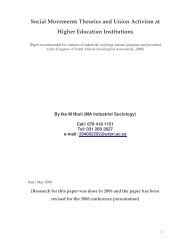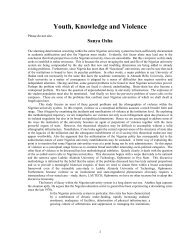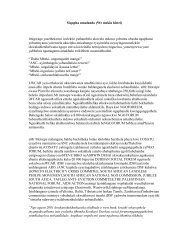April 2011 - Centre for Civil Society - University of KwaZulu-Natal
April 2011 - Centre for Civil Society - University of KwaZulu-Natal
April 2011 - Centre for Civil Society - University of KwaZulu-Natal
You also want an ePaper? Increase the reach of your titles
YUMPU automatically turns print PDFs into web optimized ePapers that Google loves.
Stories <strong>of</strong> stolen genetic treasures echo across the continent. Like<br />
traditional story tellers, when a botanist or agronomist ends his or her<br />
account <strong>of</strong> the latest theft, another joins in to give yet another account,<br />
<strong>of</strong>ten in voices <strong>of</strong> anguish and despair. Here we <strong>of</strong>fer a few details <strong>of</strong> just<br />
one current case from Southern Africa.[8]<br />
The State <strong>of</strong> the World's Animal Genetic Resources <strong>for</strong> Food and<br />
Agriculture (FAO) warns that the world's livestock production has become<br />
increasingly based on a limited number <strong>of</strong> breeds. Since 2001, an average<br />
<strong>of</strong> one breed per month has become extinct.[9] Searching <strong>for</strong> a broader<br />
genetic base by which to save a livestock industry there<strong>for</strong>e becomes an<br />
impetus <strong>for</strong> biopiracy. Accessing the gene pool <strong>of</strong> other animals with<br />
favourable characteristics is more crucial than respecting indigenous<br />
knowledge or thousands <strong>of</strong> years <strong>of</strong> breeding. In addition, if the new breed<br />
becomes marketable, the pr<strong>of</strong>its are not shared.<br />
Evolving 7,000 years ago from the wild ox, the humpless African cattle<br />
differ greatly from those brought to the continent from Asia about 3,000<br />
years ago. Tolerating tropical diseases and surviving on much less water<br />
than other breeds, Tuli cattle thrive on low-nutrient grasses; their name<br />
derives from the Ndebele word utuli, meaning dust. Custodians <strong>of</strong> the<br />
breed, the communities developed local knowledge and technologies <strong>for</strong><br />
improving the cattle within the prevailing environmental conditions and<br />
social needs (<strong>for</strong> food and draught power).<br />
In 1987, frozen embryos <strong>of</strong> Tuli cattle were shipped to Australian cattle<br />
breeders. By the 1990s, the US Department <strong>of</strong> Agriculture found that Tuli<br />
proved their merit in withstanding harsh environmental conditions. Today,<br />
the North American Tuli Association promotes the breed as follows: ‘NATA<br />
intends to expand their activities by spreading the benefits <strong>of</strong> the Tuli<br />
cattle to many countries within the Western hemisphere….the Tuli breed<br />
can provide the missing link to bridge the gap in cattle genetics, the gap<br />
being adaptation to heat and nutritional stress combined with carcass<br />
merit.’[10]<br />
Neither the government <strong>of</strong> Zimbabwe nor the <strong>for</strong>eign cattle associations<br />
consulted with the local communities or recognised their contribution in<br />
any way. NATA has even usurped the name <strong>of</strong> ‘tuli.’<br />
The current race by industrialised countries to access, research and isolate<br />
traits required by the beef industry will soon lead to the patenting <strong>of</strong> all<br />
useful genes <strong>of</strong> the Tuli cattle, without the involvement <strong>of</strong> the local<br />
communities who nurtured the breed. While Tuli traits are hailed as<br />
second to none in countries that abrogated international agreements to<br />
access the genetic materials, the peoples who developed the breed in the<br />
first place are <strong>for</strong>gotten.<br />
While research points out that the juicy and tender beef traits <strong>of</strong> Tuli<br />
cattle are transferable to other breeds, no one is willing to ensure the<br />
reverse: ‘juicy and tender’ benefits to the custodians and original breeders<br />
<strong>of</strong> Tuli cattle.<br />
AFRICAN ALTERNATIVES WORKING ON THE GROUND<br />
FARMERS' RIGHTS AND THE AFRICAN UNION MODEL LEGISLATION<br />
The international principle <strong>of</strong> farmers' rights dates from the mid-1980s,<br />
propelled by increasing demands <strong>for</strong> exclusive plant breeders' rights (PBRs)<br />
by corporate agriculture. Farmers' rights enable farmers to develop and<br />
utilise crop genetic diversity, and thereby, recognises their contributions<br />
to the global pool <strong>of</strong> genetic resources.



